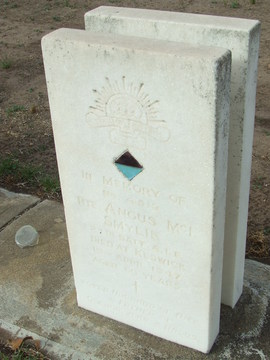
29068
SMYLIE, Angas McInnes
| Service Number: | 4519 |
|---|---|
| Enlisted: | Not yet discovered |
| Last Rank: | Private |
| Last Unit: | 27th Infantry Battalion |
| Born: | Glasgow, Scotland, 1888 |
| Home Town: | Rosefield, South Australia |
| Schooling: | Not yet discovered |
| Occupation: | Iron Moulder |
| Died: | Springbank, South Australia, Australia, 10 April 1947, cause of death not yet discovered |
| Cemetery: | Not yet discovered |
| Memorials: | Adelaide Commissioner of Public Works Roll of Honour |
World War 1 Service
| 25 Mar 1916: | Involvement Private, 4519, 27th Infantry Battalion, --- :embarkation_roll: roll_number: '15' embarkation_place: Adelaide embarkation_ship: HMAT Shropshire embarkation_ship_number: A9 public_note: '' | |
|---|---|---|
| 25 Mar 1916: | Embarked Private, 4519, 27th Infantry Battalion, HMAT Shropshire, Adelaide |
Help us honour Angas McInnes Smylie's service by contributing information, stories, and images so that they can be preserved for future generations.
Add my storyBiography contributed by St Ignatius' College
Angas McInnes Smylie was born in 1888 in Glasgow Scotland. Before his embarkation, Smylie worked as an Iron Moulder, he then enlisted to serve on the 30th of December 1915. When doing so, he was leaving behind his sister Kate Gordon, whom he also put down as his next of kin, as he did not have a partner. He was soon placed in the 27th Battalion, in the 11th Reinforcement, and embarked from Adelaide, South Australia, on HMAT A9 Shropshire, on the 25th of March 1916.
According to Smylie’s Battalion and timeline, he participated in the Battle of Flers, on the 5th of November 1916. The attacks were made in appalling conditions, with rainy weather and mud slowing down the troops, forcing them to become easy targets for German machine gunners and riflemen. The first attack was launched on the 5th of November, with some troops advancing against the trenches north of Gueudecourt, and others against complicated trenches that they referred to as ‘the maze’. Eventually, they were forced to withdraw, but not before both attacks managed to obtain some of their objectives.
Another attack was launched at the maze on the morning of the 17th of November, it succeeded in capturing a portion of the German trenches, but a surprise attack two days later returned this to Germany, but Smylie was not included due to hospitalisation.
Smylie’s medical records have him in and out of the hospital before he was eventually deemed medically unfit and returned to Australia on the 9th of November 1917. His first time in the hospital was on the 6th of November 1916, when he went due to an unknown sickness. He re-joined his unit on the 23rd of December 1916; however, it was just two months before he was admitted to the hospital sick, on the 21st of February 1917.
He was transferred to England on the 2nd of March and admitted to 1st London General Hospital, suffering from Colitis. He was discharged from the hospital in London on the 26th of April and admitted to a brigade hospital in Perham Downs on the 31st of May. On the 13th of June 1917, he transferred to Tadworth Military Hospital, suffering from gastritis. He was then transferred to 1st Auxiliary Hospital on the 9th of July 1917, suffering from Gastric Ulcers; he returned to Australia per hospital transport on the HMAT A38 Ulysses which arrived in Adelaide on the 9th of November 1917, by then his illness had been specified as gastric ulcers; he was finally discharged as medically unfit on the 29th of January 1918. His total service was 2 years and 31 days and 1 year 230 days abroad.
On July 25th 1933, Smylie missed out on receiving his medals, and so he wrote a letter to the officer in charge of base records, asking for the medals to be sent to him. Smylie passed away on the 8th of April 1947 at the age of 59.










